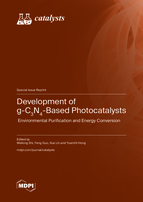Development of g-C3N4-Based Photocatalysts: Environmental Purification and Energy Conversion
A special issue of Catalysts (ISSN 2073-4344). This special issue belongs to the section "Photocatalysis".
Deadline for manuscript submissions: closed (30 September 2023) | Viewed by 17687
Special Issue Editors
Interests: photocatalytic water splitting; near-infrared light-driven; g-C3N4; ZnIn2S4; tetracycline
Special Issues, Collections and Topics in MDPI journals
Interests: tetracycline; g-C3N4; ZnIn2S4; photocatalytic H2 production; heterojunction
Special Issues, Collections and Topics in MDPI journals
Interests: photocatalytic H2 production; heterojunction
Special Issues, Collections and Topics in MDPI journals
Interests: photocatalytic H2 production; heterojunction
Special Issues, Collections and Topics in MDPI journals
Special Issue Information
Dear Colleagues,
Energy crisis and environmental pollution have become two serious problems in the further development of human society. The “Honda–Fujishima Effect” was discovered by Prof. Fujishima and Honda in 1967, which opened the way to photocatalysis. Photocatalysis is regarded as a promosing environmentally friendly technology to address the above issues due to its low energy input and carbon footprint. By converting solar energy into other forms of energy, photocatalytic technology provides a green, environmental protective, and highly economic way to solve energy problems. For instance, photocatalytic CO2 reduction into hydrocarbons and water splitting into H2 are two representative fields. Moreover, advanced photocatalytic technology also plays a significant role in solving environmental problems such as water pollutant degradation, sterilization, and antiseptics. The core of photocatalysis is the semiconductor photocatalyst. In particular, graphitic carbon nitride (g-C3N4) is a typical organic–nonmetallic semiconductor photocatalyst, which has become a research hotspot due to its unique properties, such as being innoxious, low-cost, easy to synthesize, of an appropriate energy band gap (2.7 eV) and with outstanding thermal stability and chemical stability. Nevertheless, some inherent scientific problems, containing small surface area, low utilization of visible light and fast recombination of electrons and holes, which limit its applications in the field of photocatalysis. Among enormous modification methods, the construction of a heterojunction/homojunction between g-C3N4 and other semiconductor photocatalysts with interleaved energy band position is an effective channel to improve its photocatalytic activity, which can be attributed to the accelerated photon-generated carrier transfer rate. In particular, in the emerging S-scheme structure, it can simultaneously both accelerated photon-generated carrier transfer rates and higher redox potentials. Although a large number of gratifying results have been achieved in recent years around the world, the economic benefit of photocatalytic technology is not greater than that of the standard of industrialization. Therefore, there is an urgent need to design a neoteric g-C3N4-based photocatalytic system that can further promote the development of photocatalysis. This Special Issue aims to collect recent advances in g-C3N4-based photocatalysts in energy conversion and environmental protection fields. We welcome original research, review, and perspective within the following scopes:
- The photocatalytic pollutant degradation under different water environments;
- Photocatalytic water splitting;
- Photocatalytic CO2 reduction;
- Photothermal effect-assisted catalytic performance;
- g-C3N4-based S-scheme heterojunctions;
- New fabrication and modification methods of active photocatalysts;
- Widening the light response of semiconductors to the solar spectrum;
- Enhancing the utilization of photo-generated carriers;
- New analytical techniques to probe the reaction intermediates during photocatalysis.
Dr. Weilong Shi
Dr. Feng Guo
Prof. Dr. Xue Lin
Dr. Yuanzhi Hong
Guest Editors
Manuscript Submission Information
Manuscripts should be submitted online at www.mdpi.com by registering and logging in to this website. Once you are registered, click here to go to the submission form. Manuscripts can be submitted until the deadline. All submissions that pass pre-check are peer-reviewed. Accepted papers will be published continuously in the journal (as soon as accepted) and will be listed together on the special issue website. Research articles, review articles as well as short communications are invited. For planned papers, a title and short abstract (about 100 words) can be sent to the Editorial Office for announcement on this website.
Submitted manuscripts should not have been published previously, nor be under consideration for publication elsewhere (except conference proceedings papers). All manuscripts are thoroughly refereed through a single-blind peer-review process. A guide for authors and other relevant information for submission of manuscripts is available on the Instructions for Authors page. Catalysts is an international peer-reviewed open access monthly journal published by MDPI.
Please visit the Instructions for Authors page before submitting a manuscript. The Article Processing Charge (APC) for publication in this open access journal is 2700 CHF (Swiss Francs). Submitted papers should be well formatted and use good English. Authors may use MDPI's English editing service prior to publication or during author revisions.
Keywords
- g-C3N4
- photocatalysts
- environmental purification
- energy conversion









